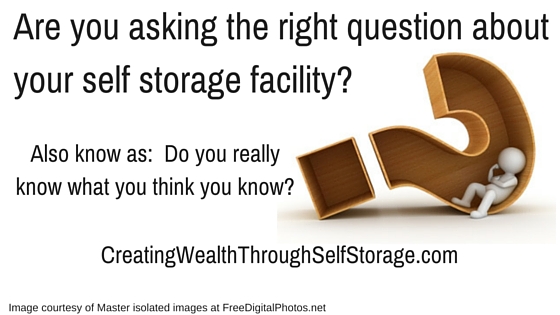Do you know one of the most meaningless numbers ever asked or ever told concerning your self storage facility?
I hear about it every day.
- “How many units we have we leased?”
- “We’ve leased “X” units.”
I know its interesting, and it does point to trends, but for the most part it is meaningless because that’s not what you need to know about your facility.
At least that’s my opinion. I have been correcting managers, partners, bankers, partners, other owners to the point that I start thinking perhaps I am off on this.
But I don’t think so. Because the number of units is not that important to me. Square footage rented is.
Every now and then I like getting on a soap box and preach. Today is one of those days.
I have seen as much as a 9% spread in the difference between units rented and square feet rented in our facilities. The reason should be obvious but it’s often overlooked.
A 5 x 5 and a 20 x 30 are two completely different things, but both are equal in the unit count world. But which would you rather have generating income?
It takes the managers the same amount of calories to rent a 5 x 5 as a 20 x 30, but one is generating income on 60% more space.
It’s almost like the difference between accrual accounting and cash accounting. Accrual gives a much more accurate picture of what is going on in a project.
If I have 100,000 square feet in a facility, and I have 85% of my square footage generating income – that really gives me information I can use to make good decisions. If I have 85% of my units rented, I still have to add one more computation (average unit size) to get information I can use.
But like everything, there’s always a catch. Can you guess what it is in the world of square footage vs. units?
I just said it. Did you miss it? It’s a little slippery.
Let me give you another example:
We have two projects in our urban brand close to each other. We run the exact same pricing for each. In other words, a 10 x 10 is the same price at both facilities and so on.
However, one has almost $1.00 per square foot more potential income than the other one. One is generating almost $1.00 more per rented square foot than the other one.
You know why?
Average unit size.
Smaller units generate more income per square foot than larger ones.
I have learned the hard way to keep my eye on this as well. In other words, I am very interested in the square feet and the average unit size.
My coaching to you is to know everything you can about the square feet of the facilities you own or are looking to purchase.
- Know the square footage size.
- Know the square footage rented.
- Know how many square feet rented are actually generating income (economic occupancy).
- Know the average unit’s square feet (Impacts $ per square feet, which has a huge impact on value).
When I am talking to a manager in a facility we are considering purchasing, and the manager knows those numbers, I consider keeping them. When the manager has no idea how many square feet are rented, I’m not too impressed.
When you begin to get your head wrapped around the world of square feet and income per square feet your decisions have a much greater impact on value than just thinking about units rented.
But I do keep trying to remember to know the number of units rented so I can get off my soap box, not kill casual conversations by explaining why that’s the wrong question, and look like I am always preaching to someone.
That is hard for a guy like me. Just ask my wife.
